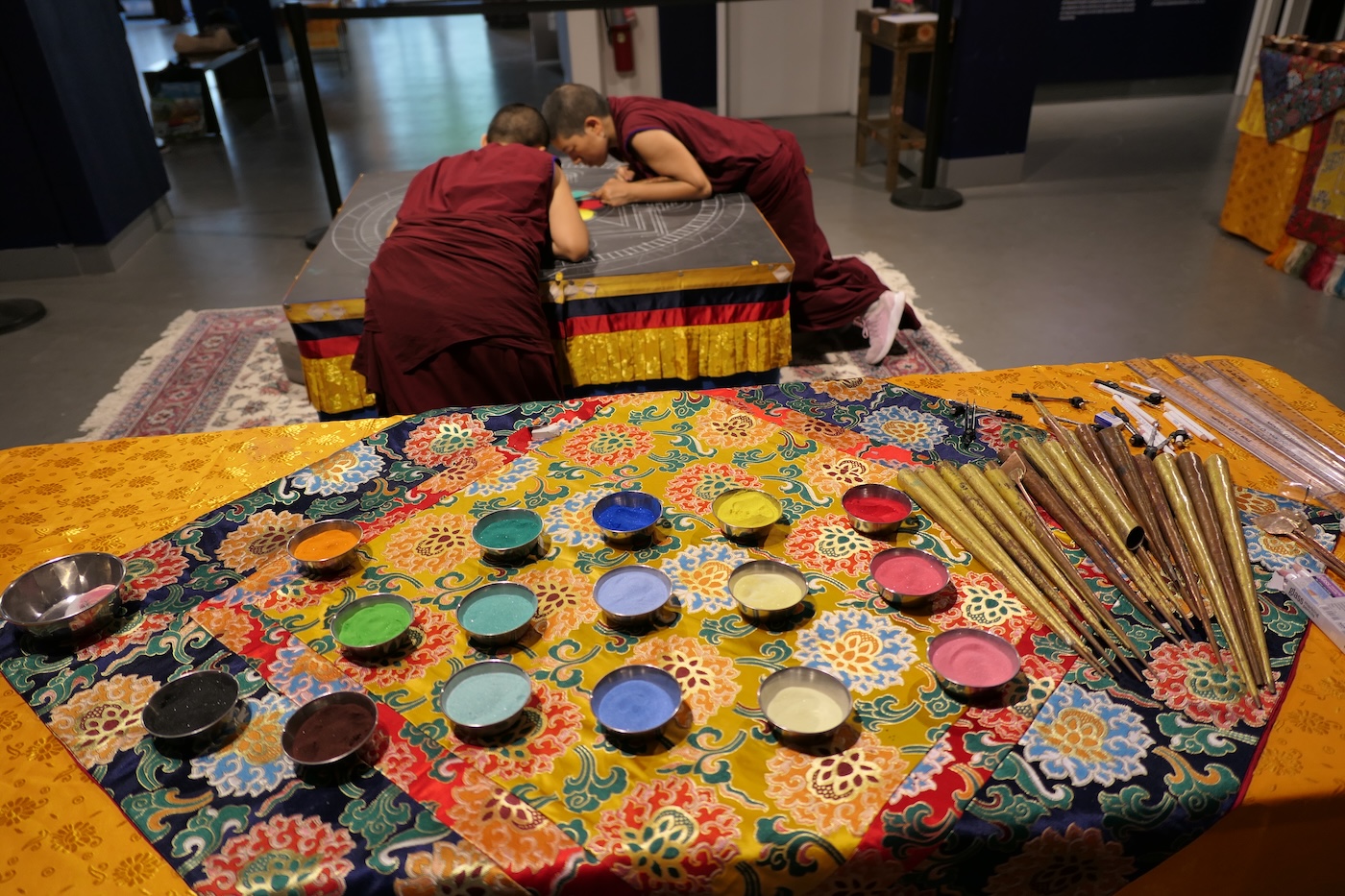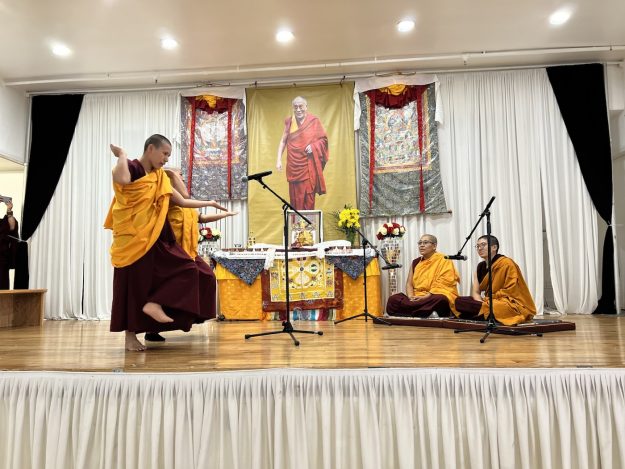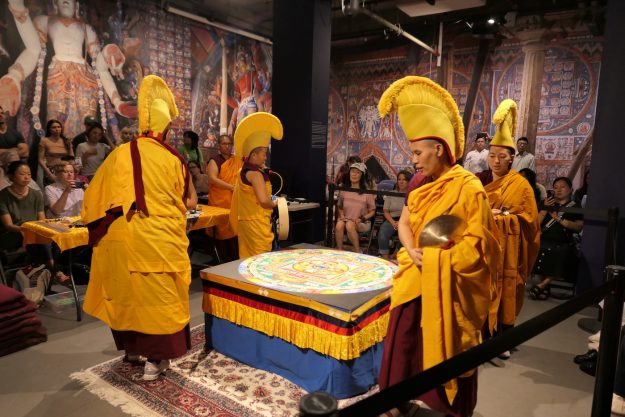Grains of Becoming
Creating sand mandalas with the Jangchub Choeling nuns The post Grains of Becoming appeared first on Tricycle: The Buddhist Review.

In the main gallery of Tibet House in New York City, five nuns huddle over a central table, diligently creating a sand mandala of the female Buddha of Compassion, Green Tara. The group—including Geshema Yeshi Sangmo, Venerable Thukten Dema, Venerable Sonam Dolma, Venerable Chung Dolma, and Venerable Sherab Dolma—are on an eleven-month tour across the United States, raising funds for their home base, Jangchub Choeling Nunnery.
Situated in the town of Mundgod, in the Indian state of Karnataka, Jangchub Choeling Nunnery is home to three hundred nuns, ranging in age from 5 to 80 years old. Many of the nuns are from Tibet. Others are from elsewhere—India, Nepal, Bhutan, Taiwan, Singapore, South Korea. In the past, monks from several of the Tibetan Buddhist monasteries in exile have traveled to the US to demonstrate sand mandala construction, but it is rare for a group of nuns to tour and publicly perform this ritual art. This is because females have received the necessary education and opportunities to do so only since around the turn of the millennium.
In Buddhist understanding, mandalas represent the divine abode, or sacred realm of a deity. In Himalayan Buddhism, every deity has an envisioned palace with corresponding iconographic elements, specific to their character. The mandala design takes a multitude of forms: thangka (Tibetan painting depicting a deity or mandala), cham (sacred dance), stupa, a three-dimensional sculpture, or a sand mandala.
Before any sacred construction can commence, the ground on which it is to be built must be consecrated. This entails a request to the local spirits to grant use of the land and to dispel any obstacles from interfering, for the benefit of all beings.
*
On the first morning of the sand mandala rite, the nuns donned their formal shawls and fringed yellow hats to initiate the mandala construction with sachok, or the ground consecration ceremony. Venerable Geshema Yeshi Sangmo is a member of the tour and leads the rite. Accompanied by chanted prayers, sacred instrumental music, and seven offering bowls—containing water for drinking, water for bathing, flowers, incense, light, perfume, and food—they invite Green Tara—the liberator of all from the ocean of suffering—into the space.
The work began with meticulous measurements, using all manner of tools—compasses, rulers, chalk-covered strings, and fine white pencils—to plot a detailed grid and outline of the design. After careful preparations, they applied the colored grains of sand using a chakpur, a narrow metal funnel, through which they skillfully dispense the grains in varied patterns and textures. Like an animation film of a Green Tara meditation, the sand mandala came to life. Out of empty space, the seed syllable “Tam,” which begins Tara’s name, appeared in the center of a moon (outline) atop a lotus. The seed syllable represents the deity.
Seven months prior to their tour, the five nuns were schooled in four standard mandalas—Green Tara, Chenrezig (Avalokiteshvara), Buddha Akshobhya, and Sangye Menla (the Medicine Buddha)—by expert monks from Gaden Monastery. Their training involved: memorizing the scriptural text underlying the mandala design; learning the technique behind creating the grid lines; and spreading the sand to create a variety of textures—as exemplified in the raised coils of the conch shell and the minuscule white dots of ornamental dakini lace. Also central to their preparation was making the colored sand from scratch with limestone powder and natural food coloring. The sand is dyed organically so that when the mandala is dissolved, the dye will not harm living beings in the water.
 Group Effort | Photo by Karen Greenspan
Group Effort | Photo by Karen Greenspan*
As part of the nuns’ visit, Tibet House organized several days of programming in addition to being open for walk-in viewing throughout the sand mandala’s creation. Part of this programming consisted of a conversation and slideshow on the Jangchub Choeling Nunnery on June 5, where the nuns shared stories about their lifestyle and the journey they took to becoming monastics. Another evening, the nuns led a discussion and meditation of Green Tara. Particularly moving were the stories of how several of the nuns were sent as children by their families to seek protection and schooling under His Holiness the Fourteenth Dalai Lama in India, who dubbed the 1987 founding of the nunnery as an educational establishment for women who wish to pursue the study of Buddhist scriptures and philosophy. Named by His Holiness, “Jangchub Choeling” translates to “place of spiritual awakening.” Unlike traditional Tibetan monasteries, this education-oriented institution for women is nonsectarian.
 Debating Nuns | Photo by Jangchub Choeling Nuns
Debating Nuns | Photo by Jangchub Choeling NunsAn essential component of monastic education in the Tibetan Buddhist tradition and at Jangchub Choeling is Buddhist philosophical debate. The central purpose of Tibetan monastic debate is to dispel ignorance (misconceptions about the nature of reality). Offering opportunities for monastics to refine their dharmic understanding, debate encourages knowledge to emerge through verbalized exchange. Nuns spend four to seven hours a day working on their debating skills. And when not debating, they are identifying and studying philosophical commentaries to back up their positions.
With its emphasis on higher education, Jangchub Choeling has twenty-two nuns who have earned their Geshema degree—the equivalent to a doctorate in Buddhist philosophy. Currently, twenty-eight more are enrolled in the four-year process, which involves an intense oral and written exam period each year covering eighteen years of prior canonical study. Venerable Geshema Yeshi Sangmo is a member of the tour and responsible for leading the ritual aspects of the sand mandala demonstration.
Each nun takes responsibility for the aspects for which they have technical strengths, helping the project move efficiently. Venerable Chung Dolma attributes the success of the project to the fact that they nurture a collaborative spirit and are all comfortable giving and receiving constructive criticism. This was demonstrated in their frequent movement around the mandala—assessing where they might be needed most and moving to that place in the diagram. The nuns developed this collaborative working style among themselves, outside of their formal training.
On the fifth day, the nuns complete the mandala of Green Tara. Astounding in detail, the mandala features intricate renderings of the eight auspicious symbols: parasol, golden fish, wish-fulfilling vase, lotus flower, conch, endless knot, victory banner, and the wheel of dharma. Thukten Dema mentions that these gifts, dazzling in their beauty, were offered to Buddha Shakyamuni after he defeated Mara and attained enlightenment.
 Mantra Circumambulation | Photo by Karen Greenspan
Mantra Circumambulation | Photo by Karen GreenspanAfterward, the nuns again put on their formal shawls and fringed hats and consecrate Tara’s mandala with prayers and offerings. They circumambulate the mandala chanting Green Tara’s mantra (Om tare tuttare ture soha), and the entire gathering joins in the chant and procession. Then, in a tangible act of cutting attachment, Geshema takes the point of her vajra and cuts through the design from multiple angles. Thukden Dema continues the process, swirling a paintbrush through the exquisite design, dissolving one form to create another—a beautiful swirl of color, with a raised mound of sand in the center. With this, the mandala is transformed into a representation of the universe, with Mount Meru at its epicenter. And just as swiftly, the nuns quickly place a brocade cloth over the mound and bless it as an offering to their teacher. Following this dedication, the grains are collected into a vase and carried to a body of water, into which the sand is poured—this is so that Tara’s blessings and the positive energy generated from this activity merge into the moving water and flow to all beings. With restrictions on city living, this is not possible in the areas surrounding Tibet House NYC, so the nuns parcel the sand into tiny bags and give it to everyone to take home with them.
The Jangchub Choeling nuns’ tour has continued to the Namgyal Monastery Institute of Buddhist Studies in Ithaca, New York; Bates College in Maine; Menla Retreat and Spa in Phoenicia, New York; and Tashi Kyil Tibetan Buddhist Institute in Kingston, New York. They will move on to Washington, D.C., from September 1–7, Minneapolis (at Minneapolis Institute of Art) from Sept 8–21, and then westward across the US bringing this profound and vivid practice of impermanence, emptiness, and interdependence for many to experience, support, and contemplate.

 Astrong
Astrong 































